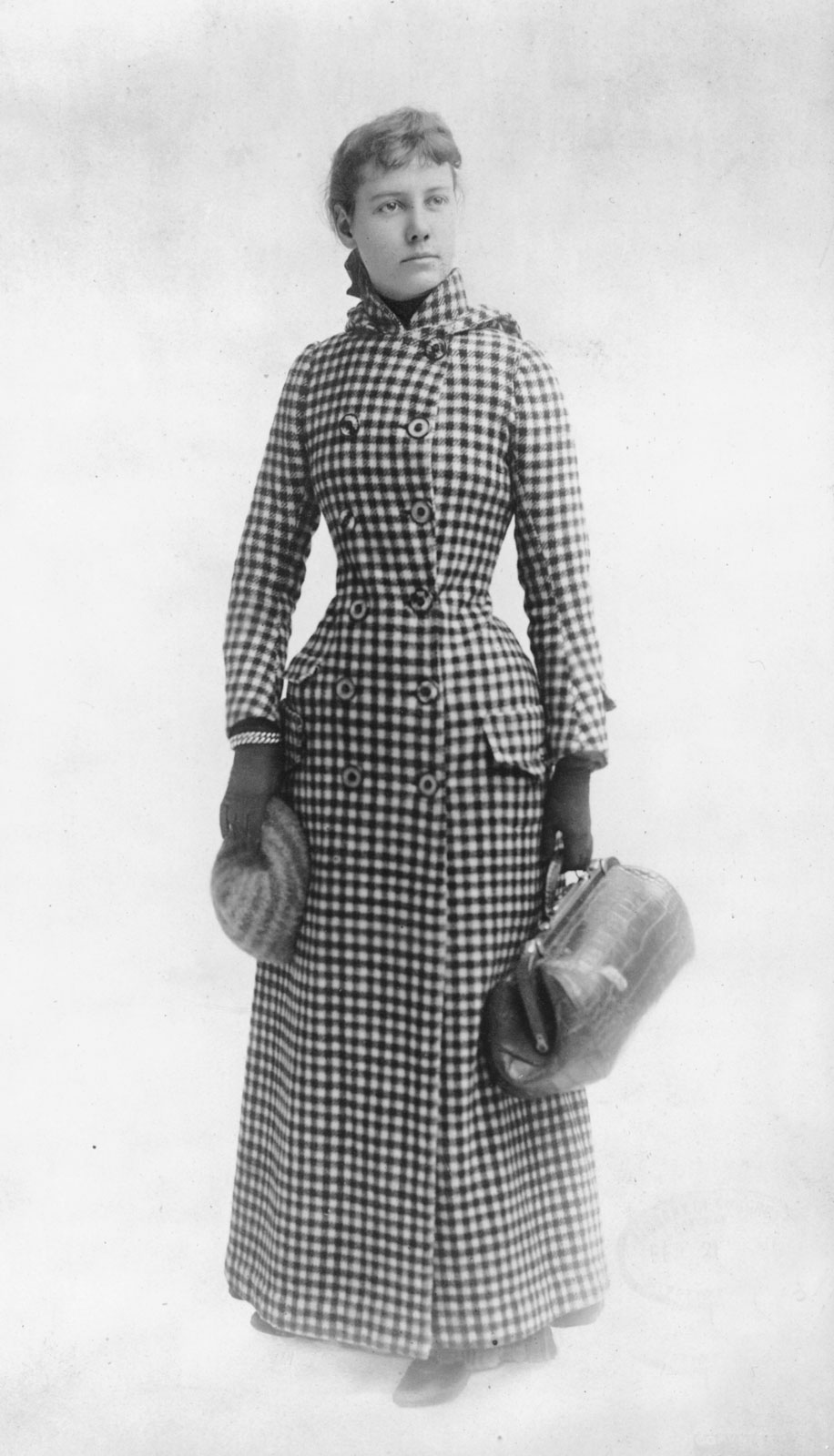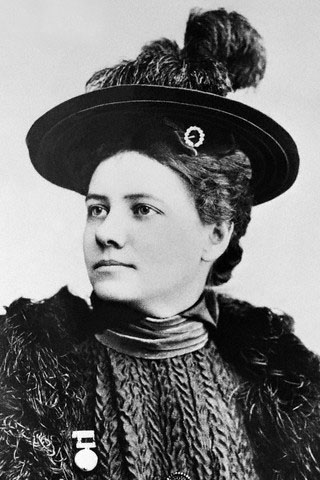The small town girl from Cochran’s Mill, PA, Elizabeth Cochran, would later become Nellie Bly and change journalism forever. Bly was one of five children and after her father’s death she was forced to work to help her mother provide for her younger siblings. The family moved to Pittsburgh shortly after, and this was where her life and career took a slightly unexpected turn.
Her career began in 1885 when she wrote an angry letter to the local newspaper, Pittsburgh Dispatch, regarding an article that had been published, entitled “What Girls Are Good For.” The piece discussed that “women were only useful for marriage and nothing else” (Stevenson). Bly submitted her angry response, explaining that she worked her whole life to help support her family. Her letter was so powerful that she was hired by the paper to be a stunt reporter, which meant she would need to dive into her stories head on. “It was for the Dispatch that she began using the pen name ‘Nellie Bly,’ borrowed from a popular Stephen Foster song” (Britannica Biographies).
Bly took her career to a new level when she began working at the “New York World.” Her first major assignment allowed for Bly to test her investigative skills at a new level. Her task was to check herself into the insane asylum on Blackwell Island, now Roosevelt Island, for ten days, and later report on her experience. She gained a lot more than she expected. It gave her the opportunity “…to see firsthand the abusive attendants, spoiled food, and freezing cold baths that the mentally ill endured on a daily basis” (Stevenson). She was able to leave the asylum after begging them to believe she was indeed a reporter covering a story. This to me is what being a journalist is all about. Submerging yourself to the point of insanity, and that is what makes Nellie Bly such a brave and successful figure still today. She put herself at risk to get the details people needed to be informed of, and that is also why readers loved her. “These events shaped her independence and drive to succeed in the male-dominated newspaper industry” (Leeper).
Her most successful endeavor started when Bly announced she was going to attempt to beat the record of Phlieas Fogg’s fictional character Jules Verne, who was famous for going “Around the World in Eighty Days.” She set off on her 72-day journey on November 14, 1889 when she boarded the Augusta Victoria, with a small suitcase and her famous checkered coat. “Bly was reputed to be a fearless character who would go anywhere and do anything for a good story” (Irish America). Her trip consisted of traveling by train, boat and even carriage to get around the globe. As she traveled she would write letters to the “New York World.” This would keep her readers updated on her journey. Bly traveled through Europe to Asia and back across the pacific to San Francisco. When she finally arrived in New York City on January 25, 1890 she was greeted with a parade and fireworks. They celebrated her victory of being the only person to make the journey in 72 days.
“Nellie Bly was the first woman in the U.S. to have her articles on the front page of a newspaper” (McCabe). As I compare journalists today to Bly, it becomes clear that reporters are not as devoted now, as she was back then. Very rarely do we hear stories of someone doing something so great, just to ensure that people are informed. Bly’s way of devoting herself to her career is admirable, and as I begin to enter the field I hope to leave an impact of some sort, whether large or small, like she did.
After an extensive time writing, she published her book, “Nellie Bly’s Book: Around the World in Seventy-Two Days.” She reflected on her trip and what she experienced during her time there; the heat wave at the Suez Canal, and the purchase of her pet monkey are a few. “Her remarkable courage and thorough reports and feature stories provoked much controversy and led to many important reforms” (Porter). Even while she was away, traveling the world, she still touched those she left behind.
Bly married Robert L. Seaman, a New York millionaire who was much older that she. They were together nine years until his death and the bankruptcy of the business he left her. At which time she decided to move to Europe to seek financial help. World War I began shortly after her move and she began writing about the war. She became the first woman to report from the frontlines and informed about the realities and devastations of war (Ward). It was a time of struggle for Bly, as she tried to support herself. She returned to New York where she began writing for the “Evening Journal” and started an advice column. Up until her death in 1922, Nellie Bly continued to devote her life to reporting.
She always struggled to seek truth, so that her readers could stay informed and hopeful. She gave people something to look forward to when they opened their papers, and without her the world of media may not have turned out the way it did. “She lived at the dawn of feminism’s birth, and was not afraid to speak her mind, despite the disapproval of society” (UWIRE). Bly gave women a passage to follow and made it okay for them to participate in journalism. She started a movement for women that can still be felt today. Where we can accomplish greatness and strive to make our communities better, through any extreme we can muster. That was Nellie Bly’s imprint on the field of journalism and media.
xo, Mal.
Photos via www.collegefashion.net | blog.tui.ua
Stevenson, Keira. “Nellie Bly.” Nellie Bly (2005): 1. MAS Ultra – School Edition. Web. 9 Apr. 2014.
Leeper, Angela. “Nellie Bly: Journalist.” Booklist 108.19/20 (2012): 79. MAS Ultra – School Edition. Web. 9 Apr. 2014.
“Bly, Nellie.” Britannica Biographies (2012): 1. MAS Ultra – School Edition. Web. 9 Apr. 2014.
McCabe, Suzanne. “Nellie Bly.” Scholastic Scope 54.13 (2006): 4-9. Academic Search Premier. Web. 9 Apr. 2014.
“Bly, Nellie.” Encyclopedia. Issues & Controversies. Facts On File News Services, n.d. Web. 9 Apr. 2014.
“Nellie Bly.” UWIRE Text 26 Mar. 2014: 1. Academic OneFile. Web. 9 Apr. 2014.
Porter, JudieJones, Trevelyn E.Gale, DavidSuhr, Virginia M.J. “Nellie Bly: Journalist (Book).” School Library Journal 35.11 (1989): 85. MAS Ultra – School Edition. Web. 9 Apr. 2014.
“Nellie Bly: Newshound.” Irish America Nov 30 1999: 112. ProQuest. Web. 9 Apr. 2014 .
“NELLIE BLY A WITNESS.” New York Times (1857-1922): 20. Oct 25 1910. ProQuest. Web. 9 Apr. 2014 .
Ward, Hiley. “Nellie Bly: Daredevil, Reporter, Feminist.” Editor & Publisher 127.35 (1994): 20. ProQuest. Web. 9 Apr. 2014.
